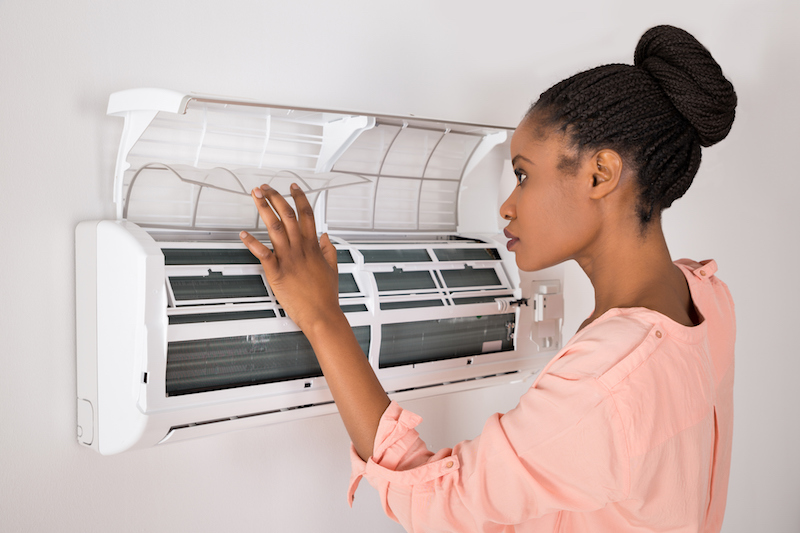
You shouldn’t need to compromise on comfort or spend a lot to keep your residence at the right temperature during hot days.
But what is the ideal temperature, exactly? We review suggestions from energy pros so you can determine the best temp for your loved ones.
Here’s what we recommend for the most energy-efficient setting for air conditioning in Omaha.
Recommended Thermostat Settings for Summer
Most people find using the thermostat at 72-73 degrees provides ideal comfort. However, if there’s a big difference between your indoor and outdoor warmth, your electricity expenses will be greater.
These are our suggestions based on the U.S. Department of Energy (DOE) and ENERGY STAR®.
While at home: 78 degrees. While that appears warm, there are approaches you can keep your home cool without having the AC running all the time.
Keeping windows and blinds shut during the day keeps chilled air where it should be—within your home. Some window solutions, like honeycomb shades or plantation shutters, are designed to deliver extra insulation and enhanced energy savings.
If you have ceiling fans in your residence, the DOE says you can move thermostat settings about 4 degrees higher without sacrificing comfort. That’s because they freshen by a windchill effect. Since they cool people, not spaces, switch them off when you leave a room.
If 78 degrees still feels too uncomfortable on the surface, try running a test for a week or so. Start by increasing your temperature to 78 degrees while you’re at your house. Then, steadily lower it while using the advice above. You could be surprised at how comfortable you feel at a hotter temperature setting.
While away: 88 degrees. There’s no rationale for keeping the air conditioner going all day while your residence is unoccupied. Turning the temp 7–10 degrees higher can save you as much as 5–15% on your air conditioning bills, according to the DOE.
When you come home, don’t be tempted to set your thermostat colder than 78 to cool your home more rapidly. This isn’t productive and often leads to a higher electrical cost.
A programmable thermostat is a helpful approach to keep your temperature under control, but you have to set programs. If you don’t set programs, you might forget to raise the set temperature when you leave.
If you want a convenient solution, consider buying a smart thermostat. This thermostat works with with your phone, so it is aware when you’re at home and when you’re away. Then it instinctively adjusts temperature settings for the best savings. How much exactly? About $180 yearly on heating and cooling, according to ENERGY STAR.
Another advantage of getting a smart thermostat? You can use your phone to keep an eye on and change temperature settings from almost anywhere.
While sleeping: Around 70 degrees. While ENERGY STAR recommends 82 degrees, that may be unpleasant for most families. Most people sleep better when their sleeping space is chilled, so that’s why the National Sleep Foundation advises 60–67 degrees. But that might be too cool, depending on your pajama and blanket preference.
We suggest using a similar test over a week, putting your thermostat higher and gradually turning it down to pinpoint the ideal setting for your house. On pleasant nights, you could discover keeping windows open at night and using a ceiling fan is a preferable idea than operating the air conditioner.
More Approaches to Use Less Energy During Warm Weather
There are additional methods you can spend less money on cooling bills throughout hot weather.
- Buy an energy-efficient cooling system. Central air conditioners only last about 12–15 years and lose efficiency as they become older. An upgraded air conditioner can keep your residence cooler while keeping cooling bills low.
- Schedule regular air conditioner tune-ups. Routine air conditioner maintenance keeps your unit operating like it should and may help it run at greater efficiency. It may also help prolong its life span, since it enables technicians to spot small issues before they create a major meltdown.
- Put in new air filters frequently. Follow manufacturer instructions for changing your air filter. A dirty filter can lead to your system short cycling, or switch on and off too much, and increase your electricity.
- Check attic insulation levels. Just about 90% of houses in the USA don’t have proper insulation, according to the Insulation Institute. The majority of southern climates require 13–14” of attic insulation, while northern climates require 16–18”.
- Have your ductwork checked. Ductwork that has come apart over time can seep conditioned air into your attic, walls or crawl space. This can lead to major comfort issues in your residence, like hot and cold spots.
- Seal cracks, doors and windows. Keep humid air where it should be by closing openings. You can also caulk or weather strip doors to keep more cold air inside.
Save More Energy During Warm Weather with The Frazier Company
If you are looking to use less energy during warm weather, our The Frazier Company pros can help. Reach us at 402-628-0206 or contact us online for more info about our energy-saving cooling options.



